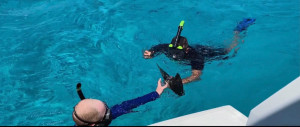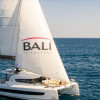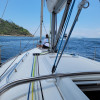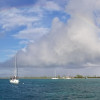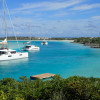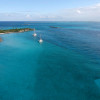My story as captain of a charter that had a significant mechanical problem
I want to share my recent story here to give a glimpse of what can go wrong on a charter and so that others might consider how they would handle similar problems.
Besides my owning and living aboard a 42 foot sailboat for a few years, I have chartered various boats about 12 times over the past decade or so. I have also completed ASA 101, 103, 104, 105, and 106. So far, I have been lucky enough to never encounter a problem like the following…
We rented a 42 foot catamaran from a major charter company in the Exumas, Bahamas. The boat was a 2020 yacht in great condition when we picked her up. Everything was going well with our charter until, on the 2nd to last day of our charter we needed to make a 30 nm sail back to Nassau be close to the charter base for our planned departures the next day.
We had spent the previous night in a slip at Highborne Cay marina. That morning we exited the slip and I noted and used full use of both engines in forward AND reverse while backing out and maneuvering out of our slip. We had no problem getting out of the slip. Upon leaving the marina through a narrow inlet channel, I noted problems with steering to starboard. With the wheel fully over to starboard the boat would only go straight. If I moved the wheel at all to port we would quickly turn to port which placed us in danger of hitting the rocks surrounding the inlet. I also had no ability to stop here as the wave and wind action would put us into the rocks in short order, so I maintained my straight heading and was just barely able to exit the marina inlet safely without hitting the rocks off our port side. Continuing to try to trouble shoot, I played around with the engine throttles and was able to determine that the port engine was not supplying any thrust, though the engine was running, revving, and was in gear. With only a starboard engine giving power, this made the boat want to spin to port, and with full rudder counter steering I could only make straight forward way.
The inability to turn to starboard presented several problems because after exiting the marina I was in a narrow cut where vessels come fast from each direction. In addition, our intended heading to Nassau was 90 degrees to starboard (the direction I could not turn) and I also had a lee shore and shallow water in nearly every direction. I was able to use shenanigans with the starboard engine to make reasonable safe way, along with drifting, to where I decided to drop an emergency anchor on the edge of the channel where we were just out of vessel traffic and slightly safe from running aground. (I say “slightly” safe because I couldn’t be sure of the anchor holding and also because the water was so shallow all around us).
I announced a “Securite” call on VHF channel 16 to announce my mechanical problem and that I had limited maneuverability in the channel and advise my emergency anchoring position. At this point, I was sure the prop was fouled with a dock line or something.
So, with the anchor seeming to hold us in position, we dove on the engine and found the port propeller was GONE. Just the engine shaft with no propeller…
We had no cell reception, but I was glad to be so close to a marina which was only about ¼ mile away. I spent about 30 minutes trying to hail the marina for assistance. I hailed them repeatedly on VHF 16 as well as the local marina channel with no success. (we later found out they had ALL of their radios off - major marina at a charter destination that charges $270 per night for a slip and where we had JUST been guests, and they weren’t monitoring VHF 16...)
Talking out loud with the crew, it seemed that we clearly had the port prop working when we first left the slip, and our problem developed moments later so it seemed likely the prop came off in the slip or in the marina. As captain, I stayed with the boat and 2 crew went back into the marina on the dinghy and sure enough found the port prop and securing cone in the slip we had been in, on the bottom in 10 feet of water!!! My wife dove down and got the parts. She was then able (in person) to get the marina staff to, somewhat reluctantly, assist us. (They apologized their radios had been off…) So anyway, she ended up offering the dock master $200 to get two marina staff to come out with a powerboat so they could tow us to a safe location. They did an assisted tow (we used our one engine when we could) and towed us about 0.5 mi to a safe anchorage. The dock master gave us advice from his boat on how to reconnect the prop and provided us with a wrench of the correct size. I reconnected the prop myself in a 2 kt current with a mask, snorkel, and the wrench from the marina crew. Once this was secure, we motored back into the marina with the assistance boat staying nearby in case we had problems again. We were able to fully maneuver and get back into a slip with no problems.
Throughout all this we were trying but unable to get a hold of our charter company on cellular or VHF. When we finally did back into the marina, we were able to call the charter company on the phone. They basically asked us what we would like them to do, as we now had the prop back on. I explained to them that I felt unsure that it would stay on and requested they send a mechanic to check the security of the replaced prop. The mechanic who arrived 4 hours later said the only thing we were missing was a locking nut, which he didn’t have, but he believed we had the securing cone on well enough that we would be okay in forward gear to go back the 30 nm to the base. He explained that reverse engine may cause the cone to loosen, but forward tightens it, so we should just try to not use reverse on that engine or do so gently if necessary.
At this point the day was lost, we were forced to pay another $270 for a slip, and had to do a twilight departure the next morning leaving at 6am to get crew back to base in time to make later flights they had paid money to re-schedule.
So basically the boat had a mechanic failure which cost us a day of our vacation and could have resulted in running aground but we prevented that. I repaired the boat myself. This was a "self-rescue" of a problem that could have been more significant, but only resulted in one lost day of chartering and late flights. I feel we handled it well and count all the lucky aspects of the situation.
First, let me address some general “sailing lessons learned” and then I will comment on “chartering lessons learned.” First, and number one was we didn’t panic. While some of the greener crew members were pretty distressed, I knew from experience that we were all safe and explicitly reassured them of this. Second, never forget your anchor, and be always ready to drop it. Our ability to instantly drop the anchor is the main thing that saved us from running aground. Third, remember your radio distress calls (“Securite”, “Pan-Pan”, and “Mayday” and what they are used for).
We were very nearby to the marina which was lucky and therefore the marina became our first and major plan for assistance. If we had not been near the marina, I am not sure what I would have done, but have contemplated the following things that I have learned about catamarans with only one working engine. First off, saildrive engines are somewhat known for throwing props. The one thing you can do to mitigate this is when going from forward to reverse, pause momentarily in neutral between each shift and be gentle. Second, catamarans WILL make good straight forward way with one engine and counter steering (many world cruisers do this to save fuel and wear on the engines). You can change directions by turning in the direction you CAN turn and spinning the boat all the way around to your desired heading. And, depending on conditions, never forget it is a SAIL boat, so don’t feel more stressed than you need to be just because your engine(s) aren’t working. Sail if you can.
Lastly, sailing is an adventure. Never give up. Learn to troubleshoot and fix things yourself if you can.
Now for the “chartering lessons learned.”
I think prior to this experience, I admit I perhaps thought in the back of my mind that if there was ANY problem, the charter company would show up like superheroes and save the day. In reality, this is rarely how it is going to play out. Communications were the issue for us - we couldn’t even reach our charter company on cellular and it was too far for VHF. And when we did finally get a hold of them it took 4 hours for them to get a mechanic to us. Chartering isn’t an “all inclusive” vacation. It’s more like mountain climbing. Self-reliance is the name of the game. Go in prepared for this and you will weather any problems much better when it takes some time for assistance to arrive.
One last issue to discuss, and that is what form of recompense from the charter company is appropriate. If I put a number on it, I would say this problem cost us $270 for an extra night at a slip we didn't intend to get, one lost day of charter (~$1700), $200 for a tow, and some flight change fees. Our charter company has yet to offer anything at all as far as a refund. Read your charter agreement carefully. Know that the customer service you will get is often in direct relation to which charter company you choose, with the largest most well-known companies offering the best service. In speaking with others, it is far more common to be offered free days on a future charter than actual cash reimbursement. Also, you might be able to request certain additional fees like fuel charges or “boat turnaround fees” be waived. As always, consider travel insurance if you think it will help you in the event of missed flights or missed work back home.
I will offer one final and important caveat. I wrote above about “self-rescue” and dealing with problems on your own. That is one philosophy and obviously my favored approach, and certainly must be so in the event of any life-threatening emergency. But consider smaller problems, like a generator, chart-plotter, or water-maker not working (or even a missing prop when you are now safe at anchor). Many would advise not doing ANYTHING mechanical to the boat that you could be held liable for. With these types of problems, it may be wise to simply put it all on the charter company to make it right while accepting that this may take some time to fix which may cost you some days of your charter.
None of this is to discourage anyone from chartering! I have chartered for over a decade and never had any problems like this before. We all had a great time on this charter and even dealing with the problem added to the adventure in retrospect. Choose a well-established charter company and you should be in good hands, especially if your expectations are in line with reality, and you maintain an adventurous and flexible mindset.
Happy sailing!

